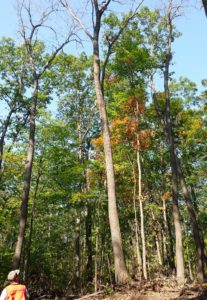
Mature northern red oaks killed by oak wilt in Sawyer County. Photo by Paul Cigan
Late-summer aerial and ground surveys revealed new oak wilt infections within northern red oak stands in Rusk, Sawyer and Washburn counties. Below is an update on the finds in each of the counties.
In Rusk County, aerial detection surveys led to the confirmation of 10 new infections on county forest property. Suspected factors for these infections include spring storm damage and latent detection of past infections caused by logging damage during unrestricted spring harvesting. The county forestry department continues to use cut-stump herbicide treatments to control below-ground transmission. They plan to continue follow-up monitoring of treated pockets and have reported encouraging results to date; only a few pockets treated between 2015 and 2016 contained newly infected oaks on or near the edge of the treatment zone.
In Sawyer County, oak wilt was found in three different oak stands on county forest property in the towns of Sand Lake and Edgewater. Two of the three infections were associated with early-summer logging damage during the high-risk period for overland spread. The stand in Sand Lake, which contained roughly 18 infected oaks, was treated with a cut-stump herbicide barrier to improve utilization of nearly 100 cut and stump-treated oaks within the root graft infection zones on this active sale.
In Washburn County, oak wilt was discovered for the first time on a private woodlot in the town of Stone Lake. Other detections were made in the town of Long Lake—one on Long Lake town property and another on the Tomahawk Scout Reservation. Two of the three infections are linked to late-spring construction damage—stem wounding and branch breakage from tree felling—during the high-risk period for overland spread. Plans are being made for a control treatment on the Stone Lake site. Members of the Washburn County Forestry Department assisted with control treatment on the town site using a frill-girdle herbicide barrier. An herbicide barrier treatment has been scheduled on the Tomahawk Scout Reservation in 2018.
For more information, visit the DNR oak wilt web page.
Written by: Paul Cigan, forest health specialist, Hayword, (Paul.Cigan@wisconsin.gov), 715-416-4920.
